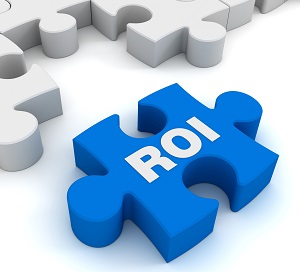Talking about the ROI
In one of our previous posts, we compared the jewelry ERP software to an employee, stating that your 'digital employee' can take over certain management tasks, eliminating several human errors that could occur during the business processes. Also, we covered an interesting topic, highlighting the differences between a generic ERP and jewelry-specific ERP software.
- Related post: Jewelry management software – your digital employee
Software implementation researches showed that price is amongst the top five deciding factors when companies choose an ERP software (it's the number 1 factor in the case of first time buyers and number 5 for second time buyers). That's completely understandable as companies are worried about the ROI.
What the ROI means when implementing an advanced jewelry ERP software?
 On paper the formula of ROI is simple. To calculate it, you simply take the gain of an investment, subtract the cost of the investment, and divide the total by the cost of the investment.
On paper the formula of ROI is simple. To calculate it, you simply take the gain of an investment, subtract the cost of the investment, and divide the total by the cost of the investment.
ROI = (Gains – Cost)/Cost
But what does that mean in the case of a jewelry business which set-off to implement a jewelry ERP software?
Usually, the costs are straightforward as they are calculated by adding up the price of the software, implementation costs and occasional customization costs.
One more cost could be added to this list: the wage of the employee who is actively involved in the implementation from the client's part. Because this cost depends on the main role of the respective employee, it can be ignored for example if he/she is the IT technician at the company.
As mentioned in our previous post, the gain of an investment can be viewed from two different perspectives:
- operating the business processes more efficiently will produce results such as increased sales, more completed orders in the same timeframe, reduced production errors and so on
- orders can be completed with less employees or with a smaller management team
These two benefits are not mutually exclusive and can cumulate depending on the business strategy.
How fast will jewelry ERP software implementation cost be recouped?
Typically, companies recoup software implementation costs between one and two years. This is in corresponding with the Panorama Consulting's 2016 annual report:
"41 percent of organizations recouped project costs in two years or less."
There are no two similar businesses, but below we try to describe a scenario on how a small business with yearly revenue of 1,500,000$ could recoup the costs.
A small business would most likely buy the Lite version of PIRO, which costs $9,990. About 20 hours of configuration and training will be necessary to prepare the jewelry ERP software for the go-live, costing $3,000 in total. If any customizations occur, the total cost of the implementation could sum up to $16000.
| Annual revenue | 1,500,000 USD |
| Estimated annual net profit (3% net profit margin) | 45,000 USD |
| Annual net profit increase (25% increase) | 11,250 USD |
| Increased net profit per month | 938 USD |
| Total cost of PIRO jewelry ERP software implementation | 16,000 USD |
| Months needed to recoup costs | 17 months |
As the above calculations indicate, if the company achieves a 25% net profit increase after the implementation of a jewelry ERP software, the costs can be recouped within 17 months . By automating workflow processes and making management tasks more efficient, this growth can be achieved with less staff or without hiring new ones.
Please like and share, if you found this article useful! Or schedule a free online demo of our jewelry ERP software.






